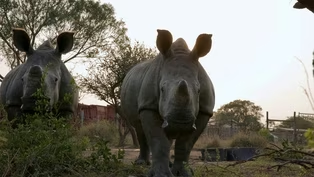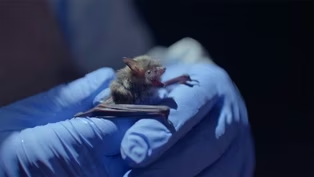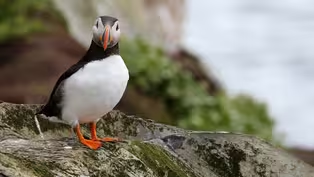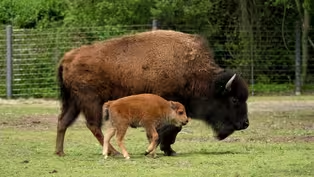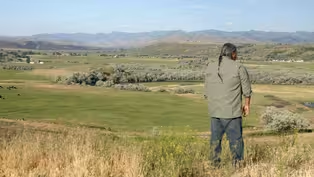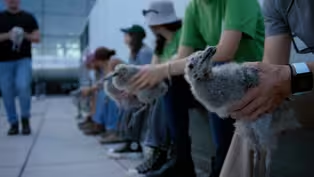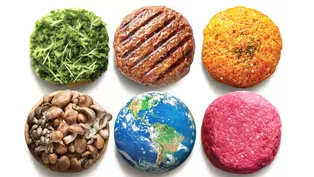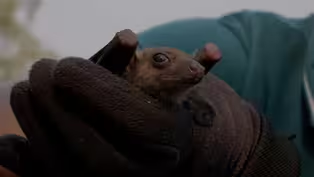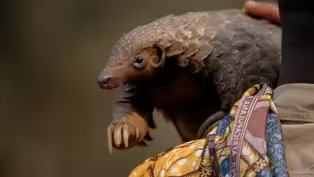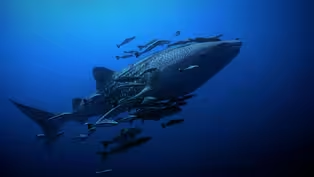
Return of the Manatees | WILD HOPE
Special | 16m 1sVideo has Closed Captions
Manatees finally return to these restored Florida rivers.
Crystal River has long been a safe haven for the Florida manatee, but when an invasive algae wiped out the eelgrass that manatees need for food, the community rallied to restore the river and save the animals that call it home.
Problems playing video? | Closed Captioning Feedback
Problems playing video? | Closed Captioning Feedback
Major support for NATURE is provided by The Arnhold Family in memory of Henry and Clarisse Arnhold, Sue and Edgar Wachenheim III, The Fairweather Foundation, Charles Rosenblum, Kathy Chiao and...

Return of the Manatees | WILD HOPE
Special | 16m 1sVideo has Closed Captions
Crystal River has long been a safe haven for the Florida manatee, but when an invasive algae wiped out the eelgrass that manatees need for food, the community rallied to restore the river and save the animals that call it home.
Problems playing video? | Closed Captioning Feedback
How to Watch Nature
Nature is available to stream on pbs.org and the free PBS App, available on iPhone, Apple TV, Android TV, Android smartphones, Amazon Fire TV, Amazon Fire Tablet, Roku, Samsung Smart TV, and Vizio.
Buy Now
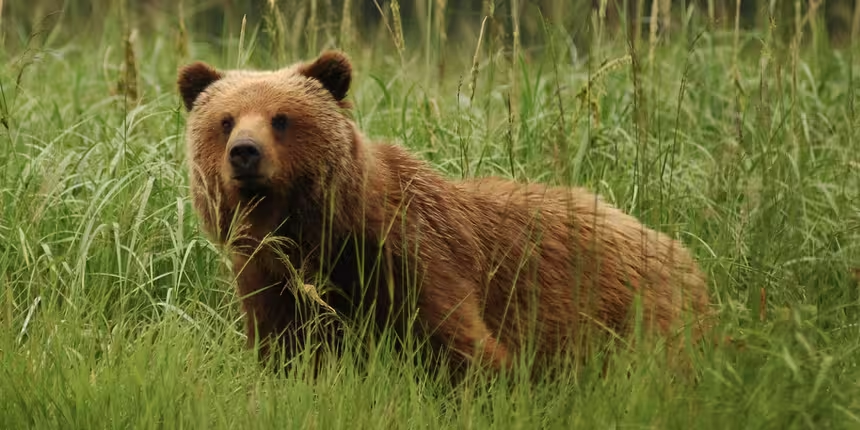
Explore More Ways to Watch
Bring the beauty and wonders of wildlife and natural history into your home with classic NATURE episodes.Providing Support for PBS.org
Learn Moreabout PBS online sponsorshipMore from This Collection
WILD HOPE is a new series of short films that highlights the intrepid changemakers who are restoring our wild places and sparking new hope for the future of our planet.
Video has Closed Captions
How does a densely populated nation like Singapore transform into a lush green oasis? (14m 51s)
Video has Closed Captions
For decades, rhinos have been the face of poaching. (16m 28s)
Video has Closed Captions
As a deadly fungus devastates North America’s bats, scientists are testing new ways to save them. (14m 47s)
Video has Closed Captions
In the Westman Islands, one community has banded together to save lost young puffins. (13m 15s)
Video has Closed Captions
Sixty million American bison once thundered across the prairies of North America. (18m 52s)
Reclaiming Bear River | WILD HOPE
Video has Closed Captions
The Bear River was once a lush area with wetlands, hot springs, and abundant wildlife. (17m 25s)
Building for Birds | WILD HOPE
Video has Closed Captions
Millions of migrating birds pass through our yards, but glass windows pose a deadly threat. (16m 3s)
Mission Impossible | WILD HOPE
Video has Closed Captions
Meet the genius behind the plant-based Impossible Burger. (39m 41s)
Pangolin Protectors | WILD HOPE
Video has Closed Captions
Due to the demand for their scales, pangolins are the most trafficked animal in the world. (12m 24s)
Way of the Elephants | WILD HOPE
Video has Closed Captions
Elephant migration corridors in India are a necessary thoroughfare for one of the largest animals. (15m 11s)
Whale Shark Homecoming | WILD HOPE
Video has Closed Captions
A renowned spiritual leader is inspiring fishermen to become guardians of the world’s biggest fish. (16m 49s)
Providing Support for PBS.org
Learn Moreabout PBS online sponsorshipLISA: Crystal River was perfect for the manatees.
(water swooshing) ♪ When you lose the basis of your ecosystem, which is your plants, everything else goes away.
♪ It just becomes a chain reaction of devastation, and that's what happened here.
We lost it all.
Our river basically died.
♪ We are a manatee refuge.
They needed food.
There was no food for them to eat.
♪ (water splashing) ♪ It's one of those situations, your house burns down.
What do you do?
You rebuild.
You have to start from scratch.
♪ (water swooshing) ♪ ♪ Growing up in Crystal River was any child's dream.
You could go out on the boat all day long, go fishing, swimming in the spring, and the water was crystal clear.
You could see fish all around you, big fish, and they would just swim by.
And manatees could come up here.
There was plenty of food, and they could bring their young.
They would have their babies here, and they would spend the winter here in our springs.
Our water's 72 degrees year round.
It was just a great habitat for wildlife.
♪ ♪ NARRATOR: Manatees, also known as sea cows, are herbivores that live in coastal rivers, bays, and estuaries.
♪ Florida manatees will travel as far north as Virginia or as far west as Texas in Summer.
But each winter they return to Florida and it's warm, spring- fed rivers and bays.
♪ Two thirds of the population now relies on the warm discharge waters from power plants.
Manatees began taking refuge there over the past 30 years as urban developments swallowed up spring-fed rivers and bays.
♪ There are still a few good natural springs remaining, and one of the best is Crystal River.
But this manatee haven was almost lost.
LISA: Back in the '70s, we had a lot of hydrilla, and that kind of filled the river.
It caused a problem.
It was an invasive fresh water plant.
♪ NARRATOR: The hydrilla depleted oxygen levels in the water and out-competed the native eelgrass, a staple of the manatees' diet.
♪ Then in the '90s, things got a whole lot worse.
(waves crashing) ♪ LISA: The 1993, they called it, "Storm of the Century" or the "No-Name Storm."
(waves crashing) We didn't know it was coming, and it blew in so much salt water from the Gulf of Mexico.
It inundated all the waterfront homes.
NARRATOR: The storm surge pushed loads of salt water into Crystal River's freshwater system.
♪ LISA: It really affected the water, but nobody knew it at the time.
♪ We were so worried about people that we didn't know that so much hydrilla was dead and fell to the bottom of the river.
♪ That caused a problem because it started to rot.
♪ NARRATOR: Eelgrass in the river fared better because it thrives in brackish water.
But the rotting hydrilla suffocated the grass and triggered an explosion of an invasive algae called lyngbya.
LISA: It turned into slime, and then it looked like the surface of the moon on the bottom.
It was noxious to animals.
It would give people rashes.
Huge plumes of nasty algae destroyed the eelgrass.
♪ NARRATOR: Manatees need to eat close to 10% of their body weight in eelgrass every day, up to 350 pounds of it.
(water swooshing) The disappearing eelgrass in Crystal River forced manatees to venture out into colder waters where it's harder to find food and where they risk dying from cold stress.
Manatees can't survive long in waters below 68 degrees.
LISA: It had never happened before, and nobody knew what to do to fix it.
I had children and grandchildren and I just kept thinking, "We can't leave it like this."
We know what this river used to be, and we have to fix this.
So neighbors got together, friends got with other friends, and we formed Save Crystal River.
MARIE: Remember how bad it was?
This park was closed.
It was probably the only time in my life I wanted to leave Crystal River 'cause it was just terrible.
NARRATOR: After watching the lyngbya take over, Lisa and her friend Marie urged the community to tackle the crisis.
MARIE: It was 2015 when we went to every school, and we asked them to write a letter about why the river was important to them.
They wrote 5,280 letters, and so then we took them to Tallahassee.
LISA: I think that was important, showing them that their opinions mattered to the legislators.
And it made an impression 'cause they knew that these people cared.
NARRATOR: The campaign also opened the government's coffers.
Soon, the community nonprofit had the funding to hire a private contractor to start restoring the river.
LISA: One day, somebody told us about a project that was similar to what we needed to have done.
They were taking out algae and replacing it with healthy eelgrass.
So they came up here, and they said, "We think we can fix this."
♪ ♪ NARRATOR: Jessica Mailliez works with aquatic restoration firm, Sea and Shoreline to replant the manatees' eelgrass on behalf of the community.
♪ JESSICA: I guess I first realized that a career working with sea grass and eelgrass would be something that I absolutely loved was when I realized that really everything depends on it.
I love the manatees, the turtles, all those charismatic creatures.
♪ NARRATOR: Eelgrass cleans the water.
Its roots hold the sediment in place, and it serves as a critical nursery for many kinds of fish.
♪ But for eelgrass to return and thrive, the lyngbya algae had to go.
(water swooshing) ♪ JESSICA: It's a nasty mat-forming algae.
It really blankets everything.
It blocks out the sunlight.
Nothing can grow beneath it.
That stuff smells awful.
I mean, it is thick.
♪ We have divers that go in and they hand vacuum the bottom.
It's hours and hours, full days, four to eight hours underwater in no visibility.
Just feeling around on the bottom and making sure that you remove all of this nasty algae.
It's a dirty job.
♪ We've removed over 500 million pounds of lyngbya and detrital muck.
♪ ♪ I think one of the proudest moments for our divers and our dredge crew is being able to uncover those large spring vents.
♪ You start going down, down, down into a hole.
And you realize when you start to feel some water gushing out that you just opened up a spring vent that's been clogged for who knows how many years.
♪ NARRATOR: The vents are like faucets delivering warm water from underground aquifers deep within the Earth.
JESSICA: We have cleaned and uncovered over 800 spring vents in the Crystal River area.
♪ (water splashing) NARRATOR: Once the algae is removed, young grasses can be planted.
(water splashing) ♪ There's a lot of river bed to cover, and it's all done by hand.
♪ Pre-rooted pods are planted every three feet.
♪ (water swooshing) JESSICA: After we plant these, we come back to check on them every single week for the first four weeks, then biweekly after that, and then every single month for a total of 12 months.
♪ NARRATOR: The community's efforts to remove the algae mats and restore eelgrass have reversed the river's decline.
♪ Manatees are once again thriving here, and tourism and fishing are both up.
♪ JESSICA: Crystal River is a huge success story.
We have some of the healthiest manatees in the state, and this warm-water refuge is also like a salad bar to them.
♪ Last winter, we had our- our highest concentr.. in this area reaching over 1,000.
♪ NARRATOR: The numbers statewide have increased significantly over the past 50 years, from a low of just a few hundred manatees in the '60s, to a high of about 9,000 in 2016.
♪ But since then, the trend has been going down again, and the Crystal River manatees are one of the few populations doing well.
♪ One of the most threatened populations is in the Indian River Lagoon, which is facing a crisis eerily similar to the one Crystal River endured.
♪ JESSICA: The Indian River Lagoon is on the east coast of Florida, and the problem that we've seen there is we had gradual sea grass loss.
And then a huge brown tide bloom came in and completely starved the grass of all sunlight, and we lost what we were already short on.
♪ (water swooshing) (equipment humming) NARRATOR: The Manatee Critical Care Center at Zoo Tampa is trying to manage the fallout.
♪ MOLLY: We've had over 500 manatees come through our doors and over 300 go back to the wild.
♪ NARRATOR: Manatees are here for a variety of reasons.
Some have been struck by boats or overexposed to cold water.
But increasingly they're being brought in because they're starving.
♪ MOLLY: All over the state of Florida, we are seeing a die off of natural sea grasses for manatees.
♪ Manatees on the East Coast, in particular, they're coming in basically starving.
They're emaciated.
They are very ill. ♪ NARRATOR: The zoo tries to save as many patients as possible.
MOLLY: Manatees have a pretty slow gestation, which means they don't give birth that often, about every two to three years.
So if you're losing a lot of adults, that can be really detrimental to the species in the long run.
♪ This year alone, we took in 17 manatees in two months, which is an incredible number.
I've seen quite a few orphans coming in our doors, and we don't really know what happened to their mother.
But they come in with no wild experience, and so we want to set them up for success.
♪ They have to gain a lot of weight when they're at the zoo.
They eat about eight hours of their day, and so that is a ton of food.
♪ We can give them romaine lettuce and things to get their body condition back up, but we need the natural vegetation in order for them to thrive.
♪ This is natural sea grass that's been collected from the wild, and today I'll be putting it in for our orphan calves.
♪ Our goal is to feed it every single day, so that way they're used to it.
♪ (water splashing) They need sea grasses out in the wi..
So it's really important that we're out there protecting the sea grasses and helping them to grow so that the manatees will be here for many years to come.
♪ ♪ NARRATOR: When the manatees from Zoo Tampa are ready to return to the wild, a destination of choice is the restored Crystal River ecosystem.
MOLLY: Crystal River, in particular, has changed and is such a bountiful environment for them that we're releasing those animals to that space.
(group cheering) ♪ NARRATOR: It's also become a model for restoration elsewhere.
LISA: We wanted everybody in the state of Florida who had a problem like this to know what we did, how we did it, how to get others involved, share this information.
NARRATOR: Along the Indian River Lagoon, conservationists are taking notice.
The region has a long road to recovery, but Crystal River has given them a roadmap for success.
♪ LISA: The Indian River Lagoon is replicating the same kind of process that's being used in Crystal River.
JESSICA: You don't have to be a scientist to be part of the solution.
You can do something as simple as not using fertilizers, pulling weeds by hand.
♪ You can even be a- a responsible boater by being conscious of here you're anchoring, making sure you're using grass-friendly anchors.
You can help educate the younger generation about the importance of creating a healthy ecosystem.
(water splashing) ♪ ♪ LISA: I think my grandchildren and all the children that are growing up now will inherit from our generation a clean, healthy river teeming with wildlife, both above and below the water.
♪ This river is the life that runs through this community.
We wanna protect it forever.
♪ ♪ ♪ ♪ ♪

- Science and Nature

Explore scientific discoveries on television's most acclaimed science documentary series.













Support for PBS provided by:
Major support for NATURE is provided by The Arnhold Family in memory of Henry and Clarisse Arnhold, Sue and Edgar Wachenheim III, The Fairweather Foundation, Charles Rosenblum, Kathy Chiao and...

